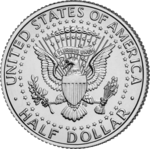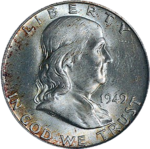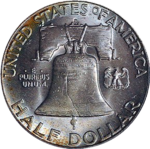Half dollar (United States)
The half dollar (English half dollar ) is a coin of the United States or a half worth 50 cents US dollars . Since 1964, the coin has featured the portrait of John F. Kennedy on the obverse and the seal of the President of the United States on the reverse . It is rarely used in daily payment transactions.
history
The half dollar was first minted in 1794. All early types have a portrait of Liberty on the front and a heraldic eagle on the back. Named after the various Liberty representations, a distinction is made between the following types:
- Flowing Hair Half Dollar (1794-1795)
- Draped Bust Half Dollar (1796–1807)
- Capped Bust Half Dollar (1807-1839)
- Seated Liberty Half Dollar (1839-1891)
- Barber Half Dollar (1892-1915)
- Walking Liberty Half Dollar (1916-1947)
Franklin Half Dollar
The "Franklin Half" was minted from 1948 to 1963. It shows Benjamin Franklin on the obverse and the Liberty Bell on the reverse . The design comes from John R. Sinnock.
Kennedy Half Dollar
The "Kennedy Half" replaced the "Franklin Half" in 1964, just three months after the Kennedy assassination . The obverse shows the portrait of John F. Kennedy , designed by Frank Gasparro; the reverse shows the seal of the President of the United States and was also designed by Frank Gasparro.
Like the earlier half-dollars, the coins from 1964 were made of 90% silver (weighing 12.5 grams). Because of the rising silver price , the coin was minted from 1965 to 1970 with a silver content of only 40% and a weight of 11.5 grams. From 1971, as with the quarter dollar and the dime , silver was completely dispensed with and copper coated with copper-nickel was used.
In 1976, for the bicentenary of American Independence , the half dollar had a special design on the back of the Independence Hall .
The half dollar in circulation
In the first half of the 20th century, the half dollar was still of great importance for payment transactions. In the 1960s, the rising price of silver, but also the new motif with the popular President Kennedy, resulted in the coin being hoarded on a large scale. In 1971, when the denomination was first minted without silver, the population had already got used to payment transactions without half dollars and hardly used the coin any more. Most coin machines do not accept half dollars, which also makes the coin unattractive as a means of payment. Since there are still reserves from earlier years that can easily meet the low demand, half-dollars have only been minted in small numbers for collectors since 2001.
Technical specifications
Since 1971 the coin has consisted of a copper core and a coating of a copper-nickel alloy. The weight proportions (based on the whole coin) are 91.67% copper and 8.33% nickel .
The coin weighs 11.34 grams with a diameter of 30.61 millimeters and a thickness of 2.15 millimeters. The edge is grooved (150 grooves).





